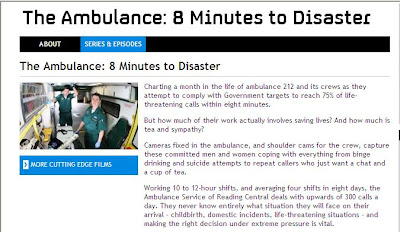 Channel 5 often features documentaries some of these include Britain's ugliest models, extraordinary people and emergency bikers. The documentary i will be focusing on is emergency bikers. This is a series following the emergency services on motorbikes looking at car accidents and medics to police officers and offences, the series follows Essex police motorbikes and west midlands ambulance service motorbikes. emergency services: 'It's not always the police cars or ambulances that get to incidents first; it's the men – and women – on motorbikes. Meet the front line heroes of Britain's emergency services as we follow West Midland's Ambulance Service biker paramedics and Essex police biker cops, and enter the world of those who daily risk their lives to save ours.' I will be analysing the first 5 minutes of emergency bikers series 1 episode 1. the scene opens with a close up of a moving motorbike followed by a pan of the bike going round the corner , this is effective as it shows how fast the motorbike is moving , in our documentary we will be using close ups. The scene opens in Birmingham with an establishing shot showing buildings and landmarks , this lets the viewer know where the scene will be set straight away.in Birmingham the documentary first focuses on the ambulance service where a 7 year old child has been ran over by a car, as medics rush to the scene on bikes POV cameras are used this is effective because is shows things from a real life perspective , but these aren't always effective because the camera can wobble which results in the picture not been clear confusing the audience. once they arrive the camera zooms to the child who has been in the accident focusing on his injuries , showing that his lower leg has been snapped . this may be disturbing for a young audience our documentary will be suitable for all ages. As the medics treat the child the camera shifts between different angles such as extreme close up and medium close up.The fairest five minutes of the programme end with a close up of a medic bandaging the child's leg and foot injuries.
Channel 5 often features documentaries some of these include Britain's ugliest models, extraordinary people and emergency bikers. The documentary i will be focusing on is emergency bikers. This is a series following the emergency services on motorbikes looking at car accidents and medics to police officers and offences, the series follows Essex police motorbikes and west midlands ambulance service motorbikes. emergency services: 'It's not always the police cars or ambulances that get to incidents first; it's the men – and women – on motorbikes. Meet the front line heroes of Britain's emergency services as we follow West Midland's Ambulance Service biker paramedics and Essex police biker cops, and enter the world of those who daily risk their lives to save ours.' I will be analysing the first 5 minutes of emergency bikers series 1 episode 1. the scene opens with a close up of a moving motorbike followed by a pan of the bike going round the corner , this is effective as it shows how fast the motorbike is moving , in our documentary we will be using close ups. The scene opens in Birmingham with an establishing shot showing buildings and landmarks , this lets the viewer know where the scene will be set straight away.in Birmingham the documentary first focuses on the ambulance service where a 7 year old child has been ran over by a car, as medics rush to the scene on bikes POV cameras are used this is effective because is shows things from a real life perspective , but these aren't always effective because the camera can wobble which results in the picture not been clear confusing the audience. once they arrive the camera zooms to the child who has been in the accident focusing on his injuries , showing that his lower leg has been snapped . this may be disturbing for a young audience our documentary will be suitable for all ages. As the medics treat the child the camera shifts between different angles such as extreme close up and medium close up.The fairest five minutes of the programme end with a close up of a medic bandaging the child's leg and foot injuries.http://www.youtube.com/watch?v=3trH-M6bxm8&has_verified=1








